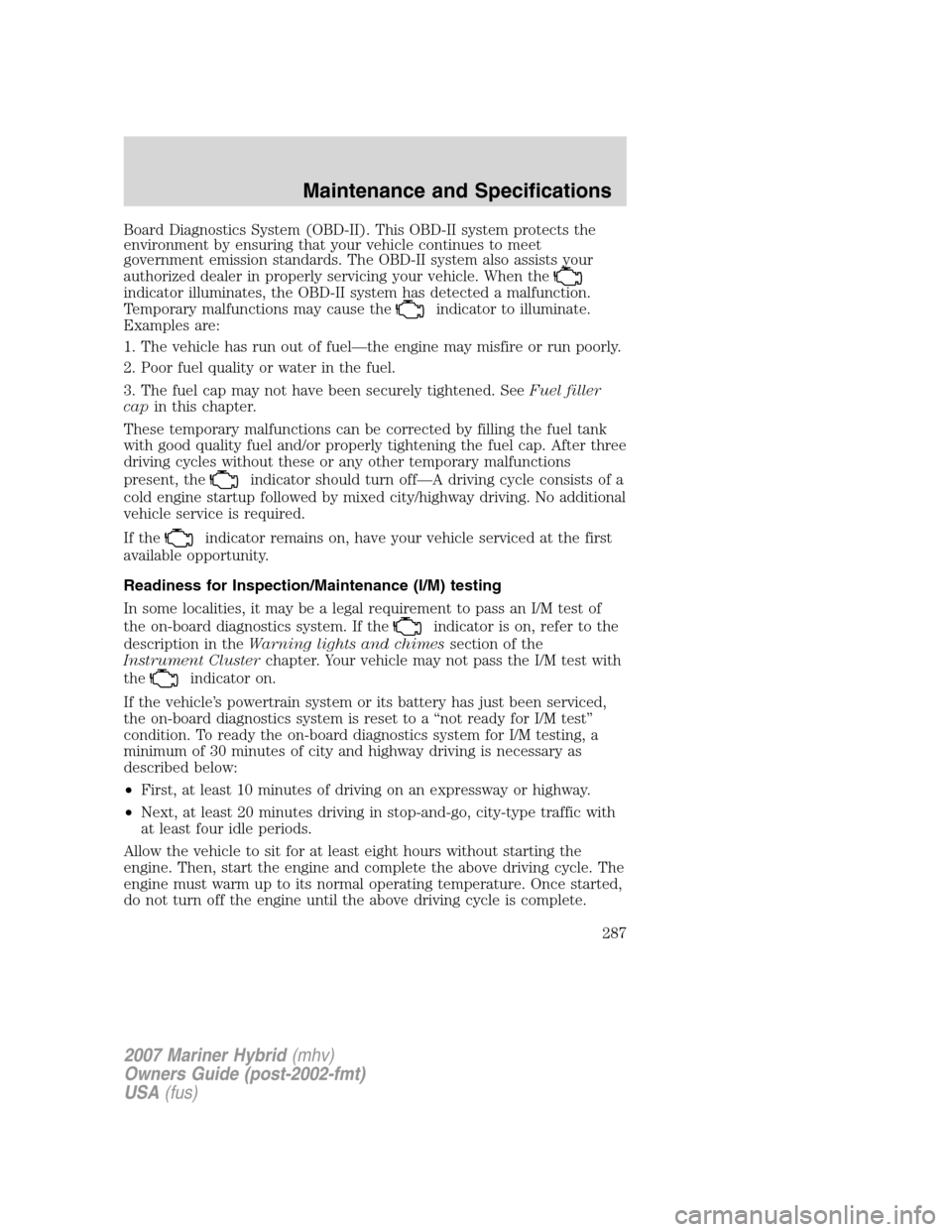Page 283 of 336

If you have run out of fuel:
•You may need to cycle the ignition from off to on several times after
refueling, to allow the fuel system to pump the fuel from the tank to
the engine.
•The
indicator may come on. For more information on the “check
engine” or the “service engine soon” indicator, refer toWarning lights
and chimesin theInstrument Clusterchapter.
ESSENTIALS OF GOOD FUEL ECONOMY
Measuring techniques
Your best source of information about actual fuel economy is you, the
driver. You must gather information as accurately and consistently as
possible. Fuel expense, frequency of fill-ups or fuel gauge readings are
NOT accurate as a measure of fuel economy. We do not recommend
taking fuel economy measurements during the first 1,000 miles (1,600
km) of driving (engine break-in period). You will get a more accurate
measurement after 2,000 miles-3,000 miles (3,000 km–5,000 km).
Filling the tank
When the fuel gauge indicates empty, there is still a small reserve of fuel
in the fuel system. When refueling your vehicle after the fuel gauge
indicates empty, you might not be able to refuel the full amount of the
advertised capacity of the fuel tank due to the empty reserve still
present in the tank. The amount of usable fuel in the empty reserve
varies and should not be relied upon to increase driving range.
For consistent results when filling the fuel tank:
•Turn the engine/ignition switch to the off position prior to refueling,
an error in the reading will result if the engine is left running.
•Allow no more than two automatic click-offs when filling.
•Always use fuel with the recommended octane rating.
•Use a known quality gasoline, preferably a national brand.
Your results will be most accurate if your filling method is consistent.
Calculating fuel economy
1. Fill the fuel tank completely and record the initial odometer reading
(in miles or kilometers).
2. Each time you fill the tank, record the amount of fuel added (in
gallons or liters).
2007 Mariner Hybrid(mhv)
Owners Guide (post-2002-fmt)
USA(fus)
Maintenance and Specifications
283
Page 287 of 336

Board Diagnostics System (OBD-II). This OBD-II system protects the
environment by ensuring that your vehicle continues to meet
government emission standards. The OBD-II system also assists your
authorized dealer in properly servicing your vehicle. When the
indicator illuminates, the OBD-II system has detected a malfunction.
Temporary malfunctions may cause the
indicator to illuminate.
Examples are:
1. The vehicle has run out of fuel—the engine may misfire or run poorly.
2. Poor fuel quality or water in the fuel.
3. The fuel cap may not have been securely tightened. SeeFuel filler
capin this chapter.
These temporary malfunctions can be corrected by filling the fuel tank
with good quality fuel and/or properly tightening the fuel cap. After three
driving cycles without these or any other temporary malfunctions
present, the
indicator should turn off—A driving cycle consists of a
cold engine startup followed by mixed city/highway driving. No additional
vehicle service is required.
If the
indicator remains on, have your vehicle serviced at the first
available opportunity.
Readiness for Inspection/Maintenance (I/M) testing
In some localities, it may be a legal requirement to pass an I/M test of
the on-board diagnostics system. If the
indicator is on, refer to the
description in theWarning lights and chimessection of the
Instrument Clusterchapter. Your vehicle may not pass the I/M test with
the
indicator on.
If the vehicle’s powertrain system or its battery has just been serviced,
the on-board diagnostics system is reset to a “not ready for I/M test”
condition. To ready the on-board diagnostics system for I/M testing, a
minimum of 30 minutes of city and highway driving is necessary as
described below:
•First, at least 10 minutes of driving on an expressway or highway.
•Next, at least 20 minutes driving in stop-and-go, city-type traffic with
at least four idle periods.
Allow the vehicle to sit for at least eight hours without starting the
engine. Then, start the engine and complete the above driving cycle. The
engine must warm up to its normal operating temperature. Once started,
do not turn off the engine until the above driving cycle is complete.
2007 Mariner Hybrid(mhv)
Owners Guide (post-2002-fmt)
USA(fus)
Maintenance and Specifications
287
Page 328 of 336

choosing the right fuel ...........281
comparisons with EPA fuel
economy estimates .................285
detergent in fuel .....................282
filling your vehicle
with fuel ..................278, 280, 283
filter, specifications ........278, 293
fuel pump/high voltage
shut-off switches ....................220
improving fuel economy ........283
octane rating ...................282, 297
quality ......................................282
running out of fuel .................282
safety information relating to
automotive fuels .....................278
Fuses ..................................221, 223
G
Gas cap (see Fuel cap) ............280
Gas mileage
(see Fuel economy) .................283
Gauges .........................................18
H
Hazard flashers .........................219
Head restraints .................119, 122
Headlamps ...................................71
aiming ........................................74
autolamp system .......................71
bulb specifications ....................77
daytime running lights .............73
flash to pass ..............................72
high beam .................................72
replacing bulbs .........................78
turning on and off ....................71
Hood ..........................................264
I
Ignition ...............................199, 297Illuminated visor mirror .............84
Infant seats
(see Safety seats) .....................160
Inspection/maintenance (I/M)
testing ........................................287
Instrument panel
cleaning ...................................258
cluster ........................................14
lighting up panel and
interior .......................................74
J
Jump-starting your
vehicle ................................240, 244
K
Keyless entry system ...............113
autolock ...................................106
keypad .....................................113
locking and unlocking doors ..114
programming entry code .......113
Keys ...........................................115
positions of the ignition .........199
L
Lamps
autolamp system .......................71
bulb replacement
specifications chart ..................77
daytime running light ...............73
fog lamps ...................................73
headlamps .................................71
headlamps, flash to pass ..........72
instrument panel, dimming .....74
interior lamps .....................75–77
replacing bulbs .........................78
Lane change indicator
(see Turn signal) ........................75
2007 Mariner Hybrid(mhv)
Owners Guide (post-2002-fmt)
USA(fus)
Index
328